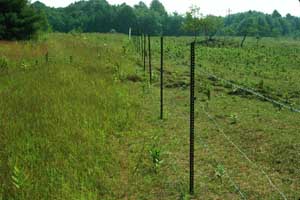|
|
 9 horses avoid milkweed DHJanzen100171.jpg high resolution
|
|
| A ungrazed (left) and heavily grazed (right) horse pasture with a large population of milkweed (Asclepias syriaca, Asclepiadaceae) plants scattered through both. Note that the horses have eaten the edible grasses and other herbs down to the minimum, while leaving each milkweed plant in perfect and unbrowsed condition. I suspect that each horse in that pasture has undergone an experience similar to that described for the bluejay earlier when it first ate a milkweed. However, it is also possible that it also learns what to eat from its mother by feeding directly (and then only) on the plants that she eats. But, there needs to be a learning (or reinforcing) experience at some point. I do not know how well horses can vomit, so the learning experience may (instead of vomiting) entail nibbling a very small amount (exploratory feeding by the colt) and then feeling miserable after that. I suspect that, as with the monarch butterfly, the horse cannot actually taste the cardiac glycosides but rather can taste a distinctive taste of the milkweed plant as a kind of marker for something disagreeable upcoming. | ||
back to lecture slides
or skip to: